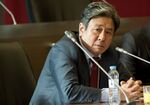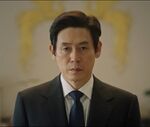Government of Joseon
 Emblem of the Government of the Great Kingdom of Joseon | |
| Formation | 11 April 1921 (Enactment of a Democratic Constitution) |
|---|---|
| Jurisdiction | |
| Legislative branch | |
| Legislature | National Assembly |
| Meeting place | National Assembly Building |
| Executive branch | |
| Leader | Prime Minister of Joseon |
| Headquarters | Jongno-Gu, Seoul |
| Main organ | State Council |
| Departments | 20 |
| Judicial branch | |
| Court | Supreme Court |
| Seat | Seocho-Gu, Seoul |
Legislative branch
The National Assembly is elected through a general election held every four years. The National Assembly has the power of no confidence in the Cabinet, the right to propose bills, and the right to deliberate on the budget bill. Since the National Assembly has the power to choose a prime minister, the power is considered to be very powerful. Because of this, various systems have been put in place to check the power of the National Assembly. The administration can dissolve the National Assembly, which requires final approval from the Supreme Court. Also, a constitutional amendment must be approved by more than 60 percent of the people after a referendum. This is to prevent undemocratic constitutional amendments by the National Assembly.
Executive branch
The administration of Joseon consists of a prime minister and 20 ministers. The prime minister is elected by the National Assembly, and the prime minister is elected after the general election or through indirect parliamentary elections when necessary. The deputy prime minister and the ministers of each department of government are recommended by the prime minister and appointed with the consent of the National Assembly.
Current members of the administration
| Position | Photo | Name | Born date | Nominated by |
|---|---|---|---|---|
| Prime Minister of Joseon | Prime Minister Park Yohan |
February 15th, 1991 (age 43) | - | |
| Deputy Prime Minister of Joseon | Deputy Prime Minister Lee Jae-Yeon |
March 20th, 1997 (age 37) | Park Yohan | |
| Minister of the Interior of Joseon | Minister of the Interior Cho Moo-jin |
June 14th, 1981 (age 53) | Park Yohan | |
| Minister of Defense of Joseon | Minister of Defense Lee Hyeyul |
April 12th, 1999 (age 35) | Park Yohan | |
| Minister of Justice of Joseon | Minister of Justice Seo Seungjo |
February 19th, 1995 (age 39) | Park Yohan | |
| Minister of Foreign Affairs of Joseon | Minister of Foreign Affairs Choi Jong-Gu |
April 25th, 1972 (age 62) | Park Yohan | |
| Minister of External Self-government Management | Minister of External Self-government Management Izabella Rodez |
April 17th, 1982 (age 52) | Park Yohan | |
| Minister of Public Service Inspection | Minister of Public Service Inspection Seo Dongho |
May 6th, 1977 (age 57) | Park Yohan | |
| Minister of the Safety of Joseon | Minister of the Safety Won Na-Kyung |
January 14th, 1999 (age 35) | Park Yohan | |
| The Chairman of Board of Audit and Inspection | The Chairman of Board of Audit and Inspection Augustin Barnier |
November 3rd, 1977 (age 57) | Park Yohan |
Judicial branch
The Supreme Court examines the final ruling on trials from lower courts, the dismissal of high-ranking officials, whether the dissolution of the National Assembly is unconstitutional, and whether the law is unconstitutional. Judges are appointed through appointment exams, but the chief justice and the justices are appointed with the consent of the prime minister and the National Assembly.
Elections
The general election to elect the National Assembly takes place once every four years under the supervision of the National Elections Commission, with direct elections involving all citizens over the age of 18.
The prime minister is elected through indirect elections through lawmakers in the presence of more than two-thirds of the lawmakers. Typically, a majority leader or a candidate put forward by the majority party is elected as prime minister, and if the number of seats in the majority party falls short of a majority, the majority party forms a coalition government with other parties.









